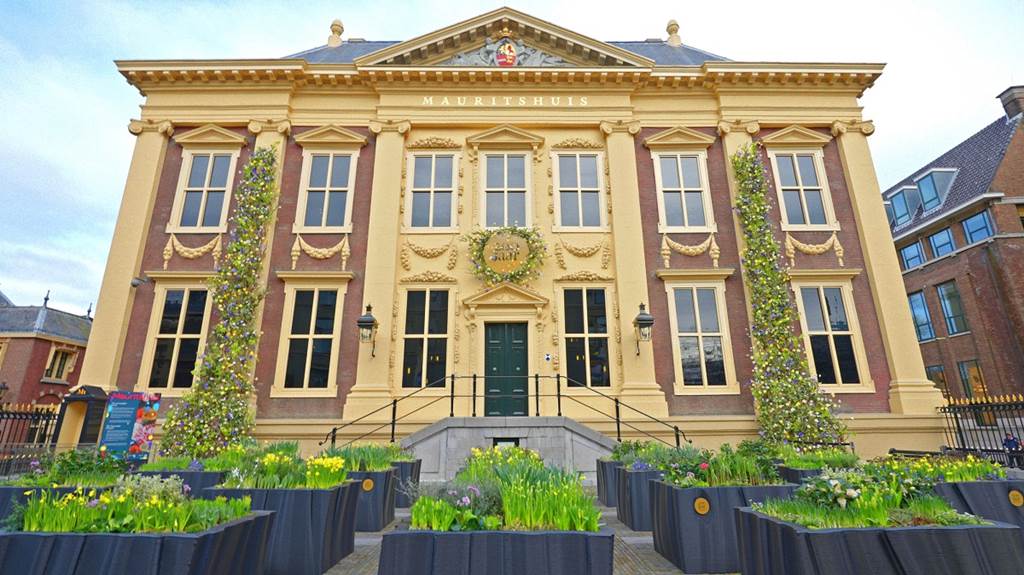
The Mauritshuis museum in the Hague is in full bloom. To celebrate the 200th anniversary of its opening to the public in 1822, the museum has been transformed into a living bouquet, inside and out.
A floral installation on the Dutch classical facade will be replenished throughout the exhibition’s run, and inside, an exhibition titled “In Full Bloom” features some of the most famous still-life works of the Dutch Golden Age. (As an added bonus, visitors with flower names—attention Lilys, Roses, and Violets—get free entrance to the exhibition.)
Originally built as a private residence, the two-story building has 16 intimately scaled jewel-box galleries, where the paintings of lush bouquets and plants are on view. The walls where the paintings are hung are also part of the show: they are covered in a sustainable material made from flower waste, imprinted with the flowers.
One of the flowers used is the Rembrandt tulip, bi-color flowers with a base color and accent “flames” of secondary hues. Those pigments give the exhibition walls their deep saturated color. At the end of the exhibition’s run, the wall panels will be turned into pieces of furniture available to purchase.
Ambrosius Bosschaert, Vase of Flowers in a Window (c. 1618). Courtesy of Mauritshuis, The Hague.
The interest in collecting and documenting exotic flowers and plants began around 1600, and the first botanical garden in the Netherlands, Hortus Botanicus, was established in the late 16th century. Many of the first canvases depicted “impossible” bouquets, juxtaposing flora that would not have ever bloomed at the same time, and arranging it in such a way that would surely have toppled the gilded vase holding the sumptuous bouquet as in Amborsius Bosschaert’s Vase of Flowers in a Window.
Throughout the century, artists became almost clinical in their treatment of each individual petal and leaf, though the compositions transitioned from impossibly staged bouquets to more messy and lifelike arrangements. Around 1630, a phenomenon known as tulipmania took hold of the Netherlands, as the price of tulip bulbs skyrocketed, converging with a skyrocketing price for bulbs, leading to mass speculation and, ultimately, a financial crisis.
There are darker themes embedded in the flora and fauna of still lifes. Rachel Ruysch, the daughter of botanist Frederik Ruysch and one of the most successful female artists in 17th-century Dutch circles, cast darker palls over her compositions, often populated by creeping insects. Though tulipmania had come and gone by 1700, Vase with Flowers includes one of the flamed tulips that had sense fallen out of fashion, as well as an iris, both well past their prime. Ruysch also included an empty stem in the center of the grouping, with its blossom severed, a not-so-subtle allusion to the ephemerality of the bouquet, and life. Like the memento mori, vanitas still-life paintings often held grim references to remind viewers of the preciousness, and precariousness, of beauty.
“In Full Bloom” at the Muritshuis is on view through June 6, 2022.
Rachel Ruysch, Vase with Flowers, (1700). Courtesy of the Mauritshuis, The Hague.
Anna Ruysch, Woodland Scene with Flowers, (1685-1687). Courtesy of the Hoogsteder Museum Foundation, The Hague.
Jan Brueghel I, Flower Still Life (c.1605). Courtesy of Kunsthistorisches Museum, Vienna.
Maria Sibylla Merian, Metamorphosis of the Oak Eggar on a Sprig of Gooseberry Blossom. Courtesy of the Mauritschuis, The Hague.
Maria van Oosterwijck, Flowers in an Ivory Cup (c. 1670-1675). Courtesy of the Mauritshuis, The Hague.
Hans Bollongier, Still Life with Flowers (1639). Courtesy of the Rijksmuseum, Amsterdam.
Willem van Aelst, Flower Still Life with a Timepiece, (1663). Mauritshuis, The Hague.
Installation view, “In Full Bloom” at the Mauritshuis, The Hague.
Installation view, “In Full Bloom” at the Mauritshuis, The Hague.
Installation view, “In Full Bloom” at the Mauritshuis, The Hague.